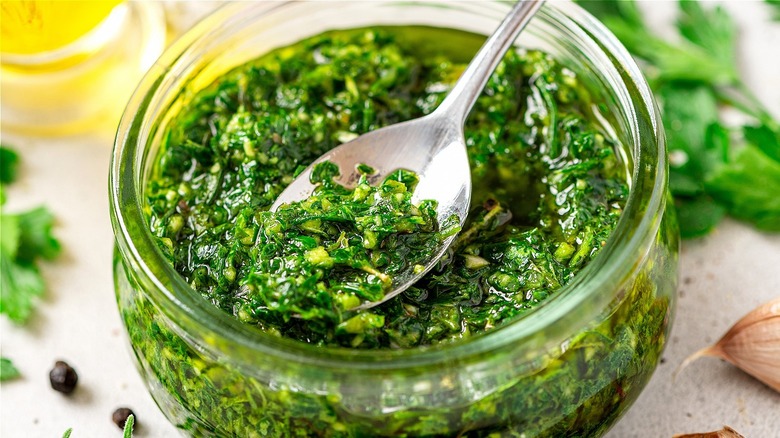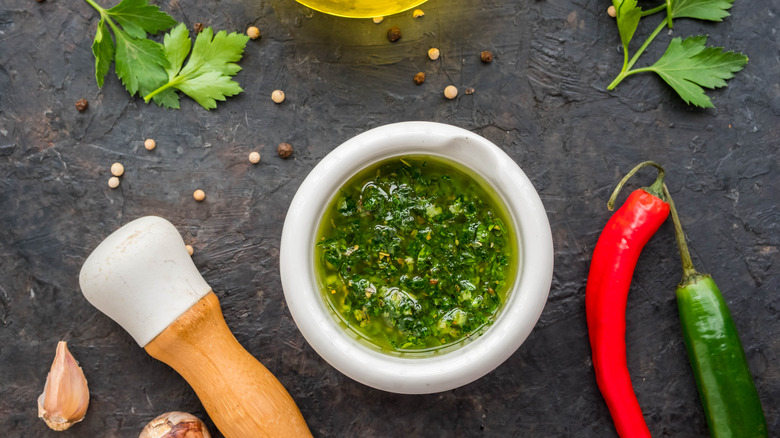No One Can Agree On How Chimichurri Got Its Name
One of Argentina's best-known culinary export is probably its meat. Grilled meat fests called asados are an essential part of local culture, and no asado would be complete without chimichurri sauce to go on the meat. Leaving out the chimichurri would be like serving burgers and hot dogs without any ketchup.
But what exactly is chimichurri? The sauce is sometimes compared to pesto (and even confused with it), but it's quite different. While both are bright green, pesto uses basil, olive oil, parmesan, and pine nuts, while traditional chimichurri is parsley-based and gets a little acidic kick from vinegar. Recipes vary but oregano, pepper, and garlic are standard ingredients. Unlike pesto, chimichurri is strictly a condiment — the many Italian immigrants who settled in Argentina wouldn't dream of using it on spaghetti.
But this key player in the region's cuisine has origins shrouded in mystery. We don't know who made the first chimichurri, how it got its name, or when, but we've got a lot of possibilities to work with.
From curry to chimichurri?
One version of where chimichurri got its start dates to the early 19th century and credits some British soldiers living in the Rio de la Plata during the (failed) attempts to seize control of the area. The British soldiers, which had also colonized India, were accustomed to having curry sauce with their meat and referred to the Latin America sauce as curry, too. Their pronunciation of "Give me the curry (Gimme curry)" devolved, through a typical telephone-game transformation, into "chimichurri."
There's another story based on a mispronunciation of Curry, but there's an Irish twist to the tale. Irish immigrant Jimmy McCurry was living in Argentina in the late 1800s and found himself longing for a sauce to go with his steak. Familiar with Worcestershire, he sought to recreate something along those lines with what was available and ended up creating something new. The sauce was named after him, and local pronunciation transformed Jimmy McCurry into "chimi-churri."
Another possibility is that the sauce got its name from the many Basques who settled in Argentina in the late 19th and early 20th centuries. There is a Basque sauce called tximitxurri that is similar in many ways to chimichurri. It features peppers, parsley, and vinegar, and when you realize that a Basque "Tx" is the equivalent of a "Ch" in Spanish or English — the name also sounds an awful lot like chimichurri.
From across the Atlantic, or closer to home?
But there's another immigrant population that could be the source of the sauce (though probably not its name). Argentina is home to a massive Italian population as well, and there is a sauce of Sicilian origin called salmoriglio, which incorporates oregano and lemon. Salmoriglio is typically served with fish and could also be the inspiration behind the mysterious origins of the great green sauce.
However, well-known Argentine journalist and author Daniel Balmacada insists that the origin of the word is much older, and hits closer to home. He contests the word is of Pre-Colombian origin, and that the native Quechua people used the term chimichurri to refer generically to any strongly-flavored sauce used to preserve or flavor different types of meat. He told the BBC, "It was a generic term used to describe strong sauces to accompany and conserve different kinds of meat."
Chef Eduardo Massa Alcantara states that the word chimichurri means friendship. Whatever the original word was, and whoever mixed the first chimichurri, there is agreement on one point: The sauce is a unifying element among all Argentines — and anyone lucky enough to share their food.


